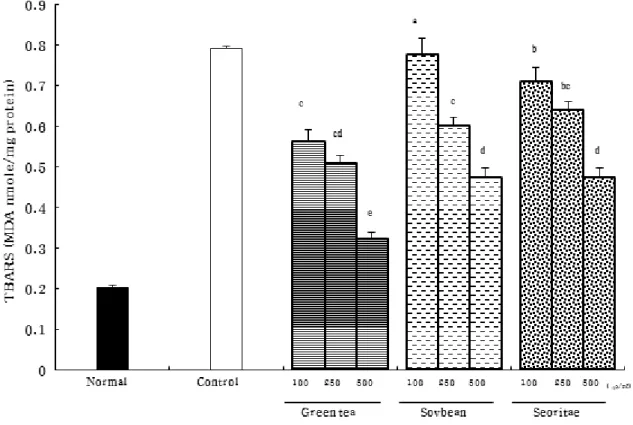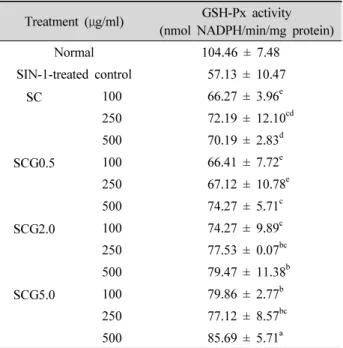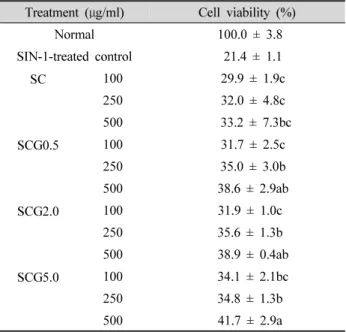녹차 첨가 서리태 청국장의 3-morpholinosydnonimine에 의한 산화적 스트레스 개선 효과
조은주
1ㆍ박현영
1ㆍ이상현
2ㆍ김현영
3*
1부산대학교 식품영양학과 및 노인생활환경연구소, 2중앙대학교 식물시스템과학과, 3경남과학기술대학교 식품과학부
Protective effects of Seoritae Chungkukjang added with green tea powder against 3-morpholinosydnonimine-induced oxidative stress
Eun-Ju Cho
1, Hyun-Young Park
1, Sang-Hyun Lee
2, Hyun-Young Kim
3*
1
Department of Food Science and Nutrition, Pusan National University, Busan 609-735, Korea
2
Department of Integrative Plant Science, Chung-Ang University, Anseong 456-756, Korea,
3
Department of Food Science, Gyeongnam National University of Science and Technology, Jinju 660-758, Korea Received on 19 October 2015, revised on 23 November 2015, accepted on 21 December 2015
Abstract : To increase antioxidative activity of Chungkukjang, the protective effect of Seoritae Chungkukjang (SC) added with green tea powder against oxidative stress was evaluated under the cellular system using LLC-PK
1cells. The treatment of 3-morpholinosydnonimine showed increase in lipid peroxidation, and decrease in endogenous anti-oxidant enzymes activity and cell viability. The methanol extract of SC inhibited lipid peroxidation by 70.9%, and significantly increased cell viability up to more than 33.2%. In addition, it enhanced superoxide dismutase (SOD) and glutathione peroxidase (GSH-Px) activities. Particularly, the addition of green tea in SC exerted protective effect against oxidative stress by ONOO- through elevation in activities of SOD and GSH-Px, and inhibition of lipid peroxidation. More addition of green tea showed stronger protective activity. These results suggest that the addition of green tea to SC leads to the increase in the antioxidative effect of Chungkukjang through elevation in antioxidative enzyme activities and protection from lipid peroxidation.
Key words : Seoriate, Green tea, Chungkukjang, Oxidative stress, LLC-PK
1, 3-Morpholinosydnonimine
*Corresponding author: Tel: +82-55-751-3277 E-mail address: hykim@gntech.ac.kr
I. 서 론
청국장은 삶은 콩에 고초균을 번식시켜 만든 전통 발효 식품으로 가장 짧은 기일에 완성할 수 있으면서도 그 풍미 가 독특하고 영양적, 경제적으로도 가장 효과적인 콩의 섭 취방법으로 인정되고 있다. 또한 청국장은 콩에서 기인된 isoflavone, phytic acid, saponin, trypsin inhibitor, tocopherol, 불포화지방산, 식이섬유, 올리고당 등의 각종 생리활성물질과 항산화물질 및 혈전용해효소를 다량 함유 하고 있기 때문에 기능성식품으로서의 중요성이 강조되고 있다(Pratt, 1972; Hammerschmidt and Pratt, 1978;
Pratt and Birac, 1979; Coward et al., 1993). 청국장에 관한 연구로는 청국장 제조의 발효에 관한 연구가 주를 이 루며, 청국장의 기능성에 관한 연구로는 혈중콜레스테롤 저하, 고혈압 예방, 항암, 항산화, 혈전용해 및 골다공증 예방 등 다양한 효과에 대한 보고가 있다(Suh et al., 1982;
Sung et al., 1984; Choe et al., 1996; Yoo et al., 1998;
Iwai et al., 2002; Shon et al., 2001; Youn et al., 2002;
Kim et al., 2003). 반면 기능성 증진에 대한 연구는 그다 지 행해지지 않은 실정이다.
항산화 기능성 증진 및 이취제거를 위해 많이 이용되어
지는 녹차는 다양한 기능성이 인정되고 있는데, 특히 항산
화효과, 항암효과, 항균효과, 혈압강하효과 등이 알려져 있
다(Yukihiko and Tadashi, 1989; Abe et al., 1995; Liao
et al., 1995; Sagesaka et al., 1996; Hibasami et al., 1998; Okubo et al., 1998). 또한, 청국장 제조 시 대부분 의 경우 대두가 주원료로 사용되고 있으나, 대두 대신 기능 성을 증진시킬 수 있는 재료로서 서리태를 들 수 있다. 서리 태는 종피의 안토시아닌 색소가 여러 가지 기능성을 나타 내는 것으로 보고되고 있다(Francis, 1989; Mazza and Miniati, 1993; Kim et al., 2005).
유산소 호흡을 하는 거의 모든 생물체의 세포에서 발생 되는 reactive oxygen species(ROS)는 독성이 매우 강한 물질로서, 생체물질의 자가 산화, 방사선, 화학물질에 의 한 외부자극에 의해 생성될 수 있는 것으로 알려져 있다 (Fridovich, 1978; Kodama, 1988). 이러한 활성산소의 종류 로는 superoxide anion(O 2 - ), hydrogen peroxide(H 2 O 2 ), singlet oxygen( 1 O 2 ), hydroxyl radical(・OH), peroxyl radical(ROO・) 등이 있다. 또한 reactive nitrogen species (RNS)로서 nitric oxide(NO)는 반응성이 크고 반감기가 아 주 짧은 특징을 갖는 활성산소로 대식세포, 호중구 등에서 생성되며 O 2 - 와 쉽게 반응하여 반응성이 매우 높은 산화제 인 peroxynitrite(ONOO - )를 생성한다(Radi et al., 1991;
Malinski et al., 1993). 이들 활성산소는 여러 가지 환경적 요인이나 병리적인 요인들에 의하여 과잉으로 생성될 수 있으며, 이들의 과다 생성과 활성산소를 제거하고 방어하 는 항산화 방어체계의 결핍은 항산화 방어체계간의 불균형 을 일으켜 산화적 스트레스를 발생시킨다(Cadenas and Davies, 2000; Bokov et al., 2004). 또한 산화적 스트레 스의 증가는 암, 심혈관 질환 및 알츠하이머와 같은 만성 질환의 병리학적 진행과 노화과정의 중요한 원인이 되는 것으로 알려져 있다(Cavalca et al., 2001; Gibson and Huang, 2005).
3-Morpholinosydnonimine(SIN-1)은 NO와 O 2 - 를 발 생시켜 결과적으로 강력한 독작용을 가진 ONOO - 를 생성 하는 물질이며, 반응에 의해 형성된 ONOO - 는 활성산소가 아니라 O 2 - 와 NO에 의해 새로운 결합을 형성하여 알칼리 pH에서 매우 안정한 특성을 갖는 강력한 산화제이다.
본 연구에서는 청국장의 항산화 기능성 증진을 위해 녹 차를 첨가한 서리태 청국장을 제조한 후 LLC-PK 1 세포계 에서 SIN-1을 처리하여 세포 독성을 유발시킨 후 청국장추 출물을 후처리하여 지질과산화와 세포생존율을 측정하여 세포독성에 대한 보호효과를 검토하였다.
II. 재료 및 방법
1. 청국장의 제조
선별한 대두(500 g)와 서리태(500 g)를 각각 수세하여 물(750 ml)을 첨가하여 15℃에서 48시간 동안 침지하고 수 절한 후 121℃에서 40분 동안 증자한 후 냉각시켰다. 녹차 는 제주도에서 재배된 야부끼다종을 장원산업에서 1차 가 공, 충북 진천군 태평양(주)에서 2차 가공한 것을 분쇄기로 분말화하여 사용하였다. 실험에 사용한 Bacillus subtilis 는 공시균주 Bacillus subtilis (KCCM 11315)로 한국 미생 물 보존센터에서 분양받아 사용하였다. 균은 glucose 0.5%
를 첨가한 NB배지(Difco, nutrient broth : beef extract 0.3%, peptone 0.5%)에 균을 각각 접종하여 37℃에서 24 시간 배양한 후, 균체 농도를 조절(흡광도 600 nm = 0.8)하 여 종균액으로 사용하였다. 전배양한 종균액(흡광도 600 nm
= 0.8)을 원료의 0.3%(v/w) 접종하고 원료에 대해 각각 0.5%, 2.0%, 5.0%의 녹차분말을 첨가하여 40℃ incubator에서 60시간 발효시켰다.
2. 시료 조제 및 추출
청국장(100 g)을 동결 건조시킨 후 시료 중량의 20배의 methanol(MeOH)로 12시간 동안 추출하는 과정을 총 3번 반복한 후 회전식 진공 농축기를 이용하여 농축시킨 후 -80℃의 냉동고에 보관하면서 항산화 실험에 사용하였다.
3. 시약
LLC-PK 1 (porcine renal epithelial cell)은 ATCC(Solon,
Ohio, USA)에서, 배양을 위한 Dulbecco’s modified Eagal
medium(DMEM)과 fetal bovine serum(FBS)는 Invitogen
Co.(Grand Island, NY, USA)에서 구입하여 사용하였으
며, SIN-1, 3-(4,5-dimethyl-2-thiazolyl)-2,5-diphenyl-
2H tetrazolium bromide(MTT), glutathione peroxidase
kit, 기타 시약은 Sigma Chemical Co.(St. Louis, MO,
U.S.A)사 제품을 사용하였고, 배양은 5% CO 2 incubator
를, 항산화 활성 및 흡광도 측정은 흡광광도계(Shimadzu
UV-2401, Kyoto, Japan)을 사용하였다.
4. 세포 배양
LLC-PK 1 세포는 100 units/ml의 penicilin-streptomycin 과 5%의 FBS가 함유된 DMEM을 이용하여 37℃, 5% CO 2
incubator에서 배양하였다. 배양된 세포는 일주일에 2∼3 회 refeeding하고 6-7일 만에 phosphate buffered saline (PBS)으로 세척한 후 0.05% trypsin-0.02% EDTA로 부착 된 세포를 분리하여 원심분리해서 집적된 세포를 배지에 넣고 피펫으로 세포가 골고루 분산되도록 잘 혼합하여 6-7 일마다 계대 배양하면서 실험에 사용하였다. 계대 배양 시 각각의 passage number를 기록하여 passage number가 10회 이상일 때는 새로운 세포를 액체질소 탱크에서 꺼내 어 다시 배양하여 실험하였다.
5. Cell Viability 측정
세포가 confluence 상태가 되면 96-well plate에 well 당 1×10 4 cells/ml로 seeding하여 2시간 incubation한 후 ONOO - 의 generator로 SIN-1(1 mM)을 24시간 처리하여 산화적 스트레스를 유발시켰다. 그 후 시료를 농도별로 처 리하여 24시간 배양한 후, 1 mg/ml의 MTT solution을 각 well에 주입하여 37℃에서 4시간 동안 재배양한 후 생성된 formazan 결정을 dimethyl sulfoxide(DMSO)에 녹여 540 nm에서 흡광도를 측정하였다(Mosmann, 1983).
6. Thiobarbituric Acid Reactive Substances (TBARS) 측정
TBARS는 Fraga 등(1988)의 방법을 변형시켜 사용하였다.
TBARS 생성 정도는 기질과 시료를 반응시켜, 37℃에서 산 화시켰다. 시간대별로 기질과 시료 반응물에다 25% TCA 1 ml와 1% TBA 1 ml을 첨가하여 95℃에서 20분간 가열하 였다. 4,000 rpm에서 30분간 원심분리한 뒤 상등액을 532 nm에서 흡광도를 측정하였다. 지질 과산화물은 malondialdehyde(MDA)의 양으로 환산하여 계산하였다.
7. 항산화 효소 활성 측정
세포가 confluence 상태가 되면 T25 flask에 5×10 4 cells/ml로 seeding하여 2시간 incubation한 후 SIN-1(1
mM)을 처리하였다. 그 후 시료를 농도별(100, 250, 500 μg/ml)로 처리하여 24시간 동안 배양한 후, 배양된 media 를 제거하고, 세포는 PBS로 두 번 세척하였다. 세포를 ice 상태에서 5초 동안 전기분해한 후 10,000 × g에서 20분간 원심분리한 상층액을 따서 실험에 사용하였다. Superoxide dismutase(SOD)활성은 Ewing과 Janero의 방법(1995)을 이용해 측정하였다. Glutathione peroxidase(GSH-Px) 활성은 commercial kit를 사용하여 측정하였고 활성 1 unit은 1분당 1 nmole의 NADPH가 산화되는 효소의 양으 로 나타내었다.
8. 통계분석
실험 결과는 평균 ± 표준편차로 나타내었고, 대조군과 실 험군의 실험 결과는 one way ANOVA로 검증한 후 Duncan’s multiple range test로 유의수준 0.05에서 유의성을 검증 하였다.
III. 결과 및 고찰
Fig. 1은 재료별로 NO와 O 2 - 의 반응에 의해 생성될 수 있는 ONOO - 를 1 mM의 SIN-1을 처리하여 유도한 후 LLC-PK 1
cells의 지질과산화 정도를 살펴본 결과이다. Control군이
1.287 MDA nmole/mg protein으로 normal군의 0.203
MDA nmole/mg protein에 비해 유의적으로 증가(84.2%)했
다. 녹차의 MeOH 추출물로 처리했을 때 지질과산화가 유의
적으로 감소해 500 μg/ml 농도에서 0.323 MDA nmole/mg
protein로 74.9% 감소하였다. 서리태는 농도의존적인 지
질과산화 저해효과를 나타내 100 μg/ml, 250 μg/ml, 500
μg/ml에서 각각 0.709 MDA nmole/mg protein, 0.640
MDA nmole/mg protein, 0.473 MDA nmole/mg protein
를 나타내 control에 비해 각각 44.9%, 50.3%, 63.3% 감소
하였다. 대두는 농도 의존적이고 유의적인 지질과산화 저
해효과를 보였고 서리태보다는 다소 낮은 저해율을 보였으
며, 500 μg/ml에서는 서리태와 비슷한 억제효과를 나타냈
다. Fig. 2는 ONOO - 에 의한 세포독성에 대한 청국장 재료
들의 보호효과를 나타낸 결과이다. SIN-1만 처리한 군은
21.4%의 세포 생존율을 나타내 normal군에 비해 78.6% 감
소했으나, MeOH 추출물을 농도별로 처리한 결과 녹차는
100 μg/ml에서 48.8%, 250 μg/ml에서 51.0%, 500 μg/ml
Fig. 1. Effect of the MeOH extract from green tea, soybean, and Seoritae on TBARS generation in SIN-1-treated LLC-PK
1cells.
Values are the mean ± SD.
a~e
Means with the different letters are significantly different ( P < 0.05) by Duncan’s multiple range test.
Fig. 2. Protective effect of the MeOH extract from green tea, soybean, and Seoritae from SIN-1-induced oxidative stress in LLC-PK
1cells.
Values are the mean ± SD.
a~d
Means with the different letters are significantly different ( P < 0.05) by Duncan’s multiple range test.
Table 1. Effect of Chungkukjang extract on SOD activity in SIN-1-treated LLC-PK
1cells.
Treatment ( μg/ml) SOD activity (unit/mg protein)
Normal 6.48 ± 0.28
SIN-1-treated control 5.06 ± 0.47
SC 100 5.08 ± 0.62
d250 5.99 ± 0.60
b500 5.86 ± 0.16
bSCG0.5 100 5.58 ± 0.14
c250 5.82 ± 0.45
bc500 5.96 ± 0.25
bSCG2.0 100 5.24 ± 0.47
d250 5.29 ± 0.43
d500 5.98 ± 0.23
bSCG5.0 100 5.29 ± 0.24
d250 5.45 ± 0.17
c500 6.34 ± 0.12
aSC: Seoritae Cungkukjang
SCG0.5: Seoritae Cungkukjang added with green tea 0.5%
SCG2.0: Seoritae Cungkukjang added with green tea 2.0%
SCG5.0: Seoriitae Cungkukjang added with green tea 5.0%
Values are the mean ± SD.
a~d
Means with the different letters are significantly different ( P < 0.05) by Duncan’s multiple range test.
Table 2. Effect of Chungkukjang extract on GSH-Px activity in SIN-1-treated LLC-PK
1cells.
Treatment ( μg/ml) GSH-Px activity (nmol NADPH/min/mg protein)
Normal 104.46 ± 7.48
SIN-1-treated control 57.13 ± 10.47
SC 100 66.27 ± 3.96
e250 72.19 ± 12.10
cd500 70.19 ± 2.83
dSCG0.5 100 66.41 ± 7.72
e250 67.12 ± 10.78
e500 74.27 ± 5.71
cSCG2.0 100 74.27 ± 9.89
c250 77.53 ± 0.07
bc500 79.47 ± 11.38
bSCG5.0 100 79.86 ± 2.77
b250 77.12 ± 8.57
bc500 85.69 ± 5.71
aSC: Seoritae Cungkukjang
SCG0.5: Seoritae Cungkukjang added with green tea 0.5%
SCG2.0: Seoritae Cungkukjang added with green tea 2.0%
SCG5.0: Seoritae Cungkukjang added with green tea 5.0%%
Values are the mean ± SD.
a~e
Means with the different letters are significantly different ( P < 0.05) by Duncan’s multiple range test.
에서 59.6%의 생존율을 나타냈고 서리태는 100 μg/ml, 250 μg/ml, 500 μg/ml에서 각각 25.2%, 30.6%, 32.2%의 세포 생존율을 보였으며, 대두는 농도가 증가함에 따라 생 존율도 증가하였는데, 500 μg/ml에서 31.8%의 생존율을 나타냈고 같은 농도의 서리태와 비교해 유의적인 차이는 없 었다. 세포실험에서 청국장 재료의 산화적 스트레스에 대한 보호효과를 살펴본 결과, 콩 품종인 서리태와 대두 중에서 는 서리태의 보호효과가 대두보다 높은 것으로 나타났다.
이렇듯 서리태가 대두보다 높은 항산화 효과를 나타내는 것 은 phenolic compound와 검정콩 종피 색소인 안토시아닌 물질이 상승작용을 하여 항산화 효과를 나타내는 것으로 추 정된다(Kim et al., 2005). 또한, 녹차는 ONOO - 의 독성에 대해서도 우수한 보호효과를 나타내 청국장에 첨가했을 때 우수한 항산화효과를 나타낼 것이라 여겨졌다.
Table 1은 LLC-PK 1 세포에서 SIN-1을 이용해 ONOO - 로 산화적 스트레스를 유발시켰을 때, 청국장의 SOD활성 에 대한 효과를 보여준다. 산화적 스트레스만 준 그룹의 SOD활성은 대조군에 비해 21.9% 감소해 5.06 unit/mg protein을 나타냈다. 서리태 청국장(SC)의 MeOH 추출물
을 처리한 결과, O 2 - 를 소거하는 SOD활성은 control에 비 해 증가했고 SC는 100 μg/ml에서 5.08 unit/mg protein (0.4%)을 나타냈고 250 μg/ml, 500 μg/ml에서 각각 5.99 unit/mg protein(18.4%), 5.86 unit/mg protein(15.8%) 을 나타냈다. 녹차첨가군 중 0.5% 녹차분말을 첨가한 군 (SCG0.5)은 농도의존적인 SOD 활성의 증가를 보여 500 μg/ml에서 5.96 unit/mg protein(17.8%)을 나타냈고, 2.0%
첨가군(SCG2.0)은 500 μg/ml에서 유의적인 증가를 보여
5.98 unit/mg protein(18.2%)을 나타냈고, 5.0% 첨가군
(SCG5.0)의 메탄올 추출물 처리 후, SOD 활성도는 농도가
높아짐에 따라 증가해 500 μg/ml에서 최대 6.34 unit/mg
protein(25.3%)을 나타났다. 이것으로 보아 SC 중에서는
특히 SCG5.0이 ONOO - 의 생성에 관여할 수 있는 O 2 - 를
H 2 O 2 로 전환시키는 SOD의 활성을 증가시켰음을 확인할
수 있었다. H 2 O 2 를 H 2 O로 불활성화시키는 항산화효소인
GSH-Px활성은 normal군에 비해 SIN-1만 처리한 그룹이
유의적으로 감소되어 57.13 nmol NADPH/min/mg protein
(54.7%)을 나타냈다. SIN-1으로 산화적 스트레스를 유발
Table 3. Effect of Chungkukjang extract on TBARS generation in SIN-1-treated LLC-PK
1cells.
Treatment ( μg/ml) TBARS (MDA nmole/mg protein)
Normal 0.203 ± 0.021
SIN-1-treated control 1.287 ± 0.012
SC 100 0.756 ± 0.004
b250 0.604 ± 0.010
c500 0.374 ± 0.015
eSCG0.5 100 0.704 ± 0.004
b250 0.550 ± 0.004
cd500 0.374 ± 0.015
fSCG2.0 100 0.629 ± 0.019
b250 0.504 ± 0.029
d500 0.359 ± 0.012
fgSCG5.0 100 0.629 ± 0.016
b250 0.514 ± 0.012
c500 0.329 ± 0.006
gSC: Seoritae Cungkukjang
SCG0.5: Seoritae Cungkukjang added with green tea 0.5%
SCG2.0: Seoritae Cungkukjang added with green tea 2.0%
SCG5.0: Seoritae Cungkukjang added with green tea 5.0%
Values are the mean ± SD.
a~g
Means with the different letters are significantly different ( P < 0.05) by Duncan’s multiple range test.
Table 4. Effect of Chungkukjang extract on cell viability in SIN-1-treated LLC-PK
1cells.
Treatment ( μg/ml) Cell viability (%)
Normal 100.0 ± 3.8
SIN-1-treated control 21.4 ± 1.1
SC 100 29.9 ± 1.9c
250 32.0 ± 4.8c
500 33.2 ± 7.3bc
SCG0.5 100 31.7 ± 2.5c
250 35.0 ± 3.0b
500 38.6 ± 2.9ab
SCG2.0 100 31.9 ± 1.0c
250 35.6 ± 1.3b
500 38.9 ± 0.4ab
SCG5.0 100 34.1 ± 2.1bc
250 34.8 ± 1.3b
500 41.7 ± 2.9a
SC: Seoritae Cungkukjang
SCG0.5: Seoritae Cungkukjang added with green tea 0.5%
SCG2.0: Seoritae Cungkukjang added with green tea 2.0%
SCG5.0: Seoritae Cungkukjang added with green tea 5.0%
Values are the mean ± SD.
a~c
Means with the different letters are significantly different ( P < 0.05) by Duncan's multiple range test.
시킨 후, 청국장의 메탄올 추출물로 처리한 결과(Table 2), SC의 경우 250 μg/ml에서 72.19 nmol NADPH/min/mg protein(26.4%)으로 증가했고, SCG0.5는 500 μg/ml에서 74.27 nmol NADPH/min/mg protein(30.0%)을 나타냈 다. SCG 2.0은 농도의존적으로 GSH-Px 활성이 증가해 100 μg/ml, 250 μg/ml, 500 μg/ml에서 각각 74.27 nmol NADPH/min/mg protein(30.0%), 77.53 nmol NADPH/
min/mg protein(35.7%), 79.47 nmol NADPH/min/mg protein(39.1%)을 나타내었다. 또한 SCG5.0은 500 μg/ml에 서 85.69 nmol NADPH/min/mg protein(49.7%)로 GSH-Px 의 활성이 급격히 증가하여 SCG5.0에 의한 H 2 O 2 의 H 2 O로 의 분해가 크게 증가했음을 확인할 수 있었다.
Table 3에서는 SIN-1으로 ONOO - 에 의한 지질과산화 에 대해 청국장의 억제효과를 나타내었다. SIN-1만 처리 하여 지질과산화만 유도한 그룹은 1.287 MDA nmole/mg protein을 나타내어 normal군의 6.3배의 지질과산화를 보 였다. 서리태 청국장의 메탄올 추출물을 처리한 후, 지질과 산화가 모두 저해되었고 농도의존적인 저해효과를 나타냈 다. 따라서 SC는 500 μg/ml에서 0.374 MDA nmole/mg
protein으로 control에 비해 70.9% 감소해 최대 저해효과
를 나타냈고, 녹차를 첨가한 SCG0.5는 100 μg/ml에서 0.704
MDA nmole/mg protein로 45.3% 감소였으나 250 μg/ml
에서 0.550 MDA nmole/mg protein, 500 μg/ml에서 0.374
MDA nmole/mg protein로 각각 57.3%, 70.9%의 감소를
나타냈다. 또한 SCG2.0은 500 μg/ml에서 0.359 MDA
nmole/mg protein로 72.1%의 감소효과를 나타냈다. SCG5.0
에서는 500 μg/ml에서 최대로 지질과산화가 억제되어 0.329
MDA nmole/mg protein으로 74.4%의 지질과산화 감소효
과를 나타내 SCG5.0이 ONOO - 의 독성이 일으킨 지질과산
화에 대해 저해효과가 높음을 확인할 수 있었다. Shon
등(2001)에 따르면 흰쥐의 간 지질에 대한 TBARS 함량으
로 볼 때 검정콩 청국장 자체로도 메탄올 추출물이 상당한
항산화 효과가 있다고 하였다. 또한, Shon 등(2001)은 대
두 청국장 추출물보다는 검정콩 청국장 추출물이 흰쥐의
간 지질에 대한 과산화 효과가 훨씬 크게 나타나 대두보다
검정콩 자체에 항산화 물질이 많을 것이라고 하였으며 대
두 청국장보다 검정콩 청국장의 isoflavone함량이 많은 이
유로서 검정콩 자체에 함유한 isoflavone함량 때문이라고
보고하였다. ONOO - 의 독성에 대해 LLC-PK 1 세포의 생존 율을 살펴본 결과(Table 4), SIN-1만 처리한 control군은 21.4%의 낮은 생존율을 나타냈다. 청국장의 MeOH 추출물 처리 후 생존율이 증가했고 SC는 500 μg/ml에서 33.2%를 나타냈다. 녹차첨가군은 농도 의존적으로 생존율이 증가했 는데, SCG0.5는 100 ㎍에서 31.7%, 250 μg/ml에서 35.0%, 500 μg/ml에서는 38.6%를 나타냈다. SCG2.0은 500 μg/ml에서 최대 생존율을 나타내 38.9%를 나타냈다.
청국장 중에서 특히 SCG5.0은 500 μg/ml에서 41.7%를 나 타내 청국장 중에서 가장 높은 세포생존율을 나타내었다.
LLC-PK 1 세포를 사용해 ONOO - 에 의해 유도된 산화적 스 트레스에 대한 청국장 MeOH 추출물의 보호효과를 살펴본 결과, 서리태 청국장의 산화적 스트레스에 대한 보호효과 를 확인할 수 있었으며 여기에 녹차를 첨가했을 때 유의적 으로 높은 보호효과를 나타내었고, 특히 녹차를 5.0% 첨가 했을 때의 효과가 가장 높은 것으로 나타났다.
IV. 요 약
본 실험에서는 청국장의 항산화 기능성 증진을 위해 녹차 를 첨가한 서리태 청국장을 제조한 후 LLC-PK 1 세포를 이 용하여 SIN-1유도 세포 독성에 대한 보호효과를 검토하였 다. 항산화능이 대두보다 우수한 서리태를 주재료로, 부재 료로 녹차를 농도별(0.5%, 2.0%, 5.0%)로 달리하여 청국장 을 각각 제조한 후 ONOO - 에 의해 유도된 산화적 스트레스 에 대해 서리태 청국장과 녹차첨가 서리태 청국장의 산화스 트레스에 대한 개선효과를 비교한 결과, 녹차첨가 서리태청 국장 추출물은 SOD, GSH-Px와 같은 항산화효소의 활성을 증가시키고, 지질과산화를 억제하여 세포생존율을 증가시 킴으로써 산화적 스트레스에 대한 보호효과를 나타냈었으 며, 특히 녹차를 5.0% 첨가했을 때의 효과가 가장 높은 것으 로 나타났다. 따라서, 녹차 첨가 서리태 청국장은 ONOO - 에 의해 유발된 산화적 스트레스를 개선함으로써 이로 인한 질 병을 예방하는 항산화제로서 역할을 할 것으로 생각된다.
감사의 글
이 논문은 2014년도 경남과학기술대학교 기성회 연구비 지원에 의하여 연구되었음.
참 고 문 헌


